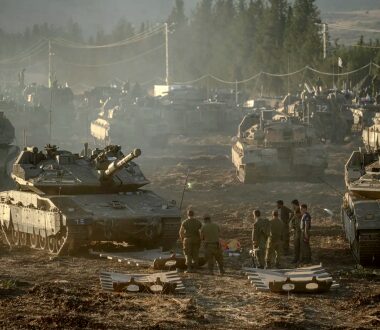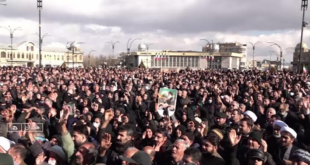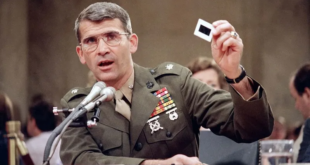The Israeli ground operation in southern Lebanon is surrounded by a lot of ambiguity from both sides, in terms of the lack of clarity of the Israeli objectives, the point at which Israel wants to stop, and its next step, as well as in terms of the latent capabilities that Hezbollah can use to raise the costs of that incursion.
The war between Hezbollah and Israel has entered a new phase since the Israeli army began its ground military operations in southern Lebanon in early October 2024, after carrying out a series of precise assassinations targeting Hezbollah’s leadership structure, all the way to its Secretary-General Hassan Nasrallah on September 27 , which was preceded by the revelation of a major security breach within the party’s ranks and its locations in both Lebanon and Syria. This raises many questions about the Israeli goals of the ground operation, especially after the emergence of indications that the Israeli demand to implement Resolution 1701 has been exceeded, towards attempts to resolve the war and create regional arrangements and new balances at the political and military levels, which means that the ground military operations may extend and expand beyond the Litani, and beyond Lebanese territory to other areas where Hezbollah is present.
Escalation contexts and strategies between the two parties
The recent escalation between Israel and Hezbollah was founded on a series of accumulated tensions and limited confrontations between them since the start of the war in the Gaza Strip, but it worsened significantly as a result of the two parties’ different readings of it. The escalation moved from the stage of limited support and attrition that Hezbollah initiated to support the Palestinian factions in the Gaza Strip since October 8, 2023, to a complex stage of balance through mutual escalation within the rules of engagement, leading to Israel regaining the initiative on the Lebanese front after it directed strikes at the party and “disproportionate” strikes that eliminated its leadership structure and targeted several weapons storage sites, leading to the ground operation and daily incursions by Israeli forces into the villages of southern Lebanon.
On the one hand, Hezbollah considered that its entry into the war as a support front for the Gaza Strip front might represent a state of exhaustion for Israel and preserve the equation of deterrence and defense between them, thus avoiding entering into a comprehensive war. Therefore, in its confrontations, it adopted the method of balance and deterrence in any military responses to show that it possesses the ability to deter, and to reflect its readiness for war if it occurred, especially since it relied on the media to show its exposure of vital areas in Israel within the framework of confirming its readiness to respond and its preparedness for any potential confrontation. On the other hand, it relied on limited missile launches towards Israeli military targets only in order to preserve the opportunity for Israel to drag the party into a war whose course and results cannot be controlled, especially in light of all the crises that Lebanon is suffering from and in light of the interim prime minister, and the vacancy in the position of president and governor of the central bank.
Israel read the party’s involvement in the war as part of a broader Iranian goal to undermine the Israeli system, especially with its possession of advanced weapons, drones, and precision missiles of various ranges, which prompted it to adopt a policy of preemptive strikes , to prevent the party from taking the initiative to carry out attacks similar to the events of October 7 from the Galilee. Therefore, during the first months, it focused on assassinating the field commanders of the party’s units in southern Lebanon, before moving on to strike various leadership, operational, and operational levels with the aim of creating a structural vacuum in the party that would not only restrict its ability to take the initiative, but also expose it to serious risks to its existence. This prompted Israel to go beyond its previous demands to implement Resolution 1701 to try to disarm the party and weaken it to the maximum extent, both in the Lebanese and regional arenas.
Israeli ground operation in Lebanon
In early October 2024, the Israeli army began limited ground incursions into southern Lebanon. It announced that the goal of the operation, dubbed “Arrows of the North,” was to destroy Hezbollah’s infrastructure along the border and reduce the party’s threat of rocket fire, especially short-range ones, in order to prepare for the return of settlers to their settlements in northern Israel. This came after Israel transferred its military momentum from the Southern Military Command, responsible for the fighting in the Gaza Strip, to the Northern Command, responsible for Lebanon, where five military divisions (the 98th, 91st, 36th, 146th, and 210th Divisions) operate under its command.
In fact, Israeli tactics in the villages adjacent to the border are similar to its actions in the Gaza Strip, as it issued evacuation orders to the residents of those villages, and on October 16, Israeli forces completely blew up the “town of Mahbib” located on the border. It seems that Israel is trying to empty those villages of infrastructure, to create a reality that makes it difficult for Hezbollah elements to move in those areas, and to limit their ability to reach the border strip. In the future, this tactic will increase the costs of targeting Israel from the villages located along the distance from the Litani to the border, which will be subject to evacuation and destruction orders by Israel. In addition, Israel is trying to keep the party and its supporters in a state of shock and frustration, as it reveals from time to time video clips of underground tunnels, confiscated weapons, and prisoners whose interrogation records have been published.
In contrast, while Hezbollah has lost its command structure, it is showing cohesion on the ground, with battalions deployed on the ground apparently operating independently and with limited contact with operations rooms. It is still capable of launching large-scale rocket attacks against northern Israel and Haifa, as well as attacks on Israeli forces stationed on the border and artillery positions, and carrying out qualitative attacks such as the one that targeted a Golani Brigade training camp on October 14. In a speech, the party’s interim secretary-general, Naim al-Qassem, stated that the party’s military capabilities remain intact, and that Israel has not been able to advance since its ground incursion into Lebanon.
Expected paths of the Israeli ground operation
The ground operation is still in its early stages and is surrounded by a lot of ambiguity from both sides, in terms of the Israeli objectives, the point at which Israel wants to stop, and its next step, as well as the latent capabilities that Hezbollah can use to raise the costs of this incursion, especially since the confrontations on the ground seem more complicated than the rapid results of air operations, especially in light of the mountainous environment in the south that gives the defender an advantage over the opponent, in addition to the experience acquired by the party’s fighters through their external participation in Syria, especially the Radwan Force, which is still capable of luring Israeli soldiers and carrying out ambushes, despite the assassination of its entire leadership structure. In fact, the scope of the operational capabilities of both sides determines the scenarios and future of the Israeli ground operation and the content of its objectives as follows:
Track One : Establishing a Security Belt Controlled by Israel
The systematic incursions and destruction of border villages reflect Israeli intentions to establish a security belt along the 100-kilometre border, with a depth that may reach 5 kilometres. Work on this path began since the outbreak of the escalation, as most of the Israeli strikes were concentrated in this geographical area, and chemical phosphorus was used in it, according to an investigation published by the British Financial Times in late June, which made the area unfit for living or agriculture. In fact, Israel has strengthened the idea of security belts since the outbreak of the war, as it is working to expand the safe zone on the border between the Gaza Strip and its envelope, with a depth of one kilometre inside the Strip. Reports indicate that the Israeli forces are working to establish a “safe fence” 200 metres deep inside Syrian territory, and what is likely to be sufficient in this path; The repeated announcements by Israeli officials about the limitations of their penetration, and that the ground forces face many restrictions in carrying out a large-scale ground campaign, due to the shortage of tanks, as announced by the Israeli army on July 15, and its announcement of new procedures for the use of heavy ammunition due to the shortage of its stocks on October 13, in addition to the fatigue that has befallen regular and reserve soldiers as a result of their involvement for a year in the war in the Gaza Strip, and these problems may be exacerbated in the event of a large-scale ground invasion into Lebanon.
Track Two : Withdrawal while preserving Israel’s operational freedom
This path is determined in light of the difficulties that the Israeli army may face in its ground incursion, the possibility of increasing the material, human and military costs of the incursion, and the difficulty of maintaining the Lebanese border areas or controlling the land or succeeding in establishing a safe zone. This may reinforce Israeli fears of being dragged into a war of attrition that may extend for years. In light of the party’s desire to reorganize its ranks, and the acting Secretary-General’s threat to accept the party’s implementation of Resolution 1701, it is likely that Israel will agree to implement the resolution but with the addition of amendments to it, allowing the Israeli army operational freedom in the southern border areas, and preventing Hezbollah from restoring its infrastructure on the border, especially since Israeli officials have accused the United Nations Interim Force in Lebanon (UNIFIL) of being useless, and the army has summoned foreign journalists to photograph a tunnel opening 200 meters from a UNIFIL camp. These may be preludes to adding amendments to UN Resolution 1701, which was adopted in July 2006.
The third path : penetration into southern Lebanon
The slow and low pace of Israeli ground incursions into southern Lebanon indicates that the army is still in the reconnaissance phase, by monitoring Hezbollah’s defensive behavior and tactics, and trying to uncover hideouts, tunnels, and military sites, in order to launch a ground attack using a large number of Israeli forces in various formations, and to penetrate deep into southern Lebanon, specifically Hezbollah’s traditional strongholds in the south, as Israel realizes that the first and second paths will not achieve complete security for the settlements, especially from long-range weapons such as missiles and drones, and this requires military action in the entire south, which will lead to weakening the party in the field and complete its structural weakening, especially since eliminating the Radwan Force is considered a clear Israeli goal, and its leadership structure was one of the most prominent assassinations carried out by Israel, starting with its field commander Wissam al-Tawil in January 2024, and the force commander Ibrahim Aqil, who was killed along with 20 others from the unit’s leadership, including its training officer Ahmed Wahbi in September 2024.
Fourth track : Operational expansion into the Lebanese interior
In the event of operational success in implementing the first and third tracks, and in the event of Hezbollah’s limited response continuing, the Israeli objectives may expand to operate militarily deep inside Lebanon, including the capital Beirut, as the Israeli objectives of the war have expanded, and are not limited to the armed factions in the Gaza Strip, or Hezbollah in Lebanon, but rather to undermine the “unity of the arenas” in which Hezbollah is considered a fundamental pillar, especially since Israel is expanding its targeting of the party in all areas of its presence, especially in Syria, which makes the southern suburb a target for Israel that weakens the party to its maximum limits and strips it of its legitimacy among its incubator, and weakens its position in front of other Lebanese forces. Also, the attack on the party’s strongholds in the suburb may not be carried out in the form of a direct ground incursion, but may take the form of airdrops and quick and lightning raids by Israeli special forces and airborne forces.
However, despite Israel’s operational and intelligence superiority, these paths are surrounded by several complications, some of which are field-related and some of which are related to regional and international positions. On the one hand, Hezbollah continues to demonstrate its capabilities in confronting Israeli ground incursions, and there are increasing indications of its recovery from a series of previous strikes. Regional countries and the international community have also begun to realize the breadth of Israeli targets in a way that could plunge the region into an unprecedented state of turmoil. For example, the United States opposed the raids carried out by Israel on Beirut, and is trying to prevent it from targeting the capital, especially the southern suburbs. These pressures will increase the longer the ground incursion into Lebanon continues, which is unlikely to be quick given the many field complications.
 Eurasia Press & News
Eurasia Press & News




